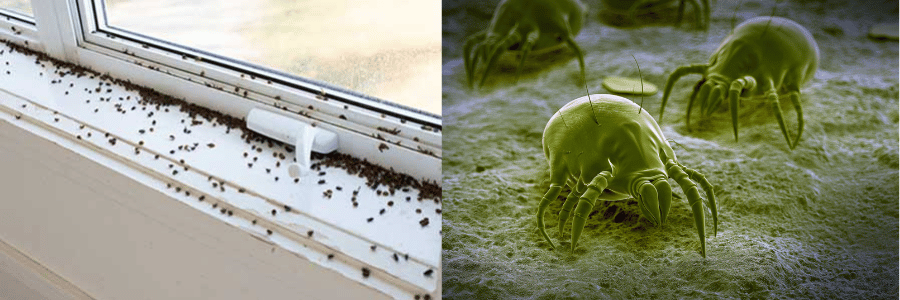If you suffer from allergies or asthma, you know how difficult it can be to keep your home environment clean and comfortable. From dust and pollen to mold and pet dander, allergens can sneak into your home through gaps, cracks, and inefficient windows. The good news is that replacing old windows with modern, energy-efficient ones can significantly improve your indoor air quality and help make your home a more allergy-friendly space. Here’s how new windows can help reduce allergens and create a healthier home environment.

1. Tight Seals = Fewer Allergens Infiltrating Your Home
One of the biggest culprits when it comes to allergens entering your home is gaps and leaks in your windows. Older windows, especially those with worn-out weatherstripping or damaged seals, allow dust, pollen, and other airborne particles to enter your home. These tiny gaps might seem insignificant, but they can be a major source of indoor allergens.
Modern windows, however, are designed with advanced sealing technology to create an airtight barrier. Features like improved weatherstripping, double- or triple-sealing mechanisms, and high-quality frame materials (like vinyl or fiberglass) help to prevent outdoor allergens from getting inside. When your windows fit snugly and are properly sealed, the air inside your home stays cleaner, and allergens are kept at bay.
2. Triple-Pane Glass Reduces Dust and Outdoor Pollutants
Another reason to upgrade your windows is the addition of triple-pane glass. Unlike traditional single-pane or even double-pane windows, triple-pane windows provide an extra layer of glass and a gas-filled space between the panes that enhances insulation and soundproofing.
While triple-pane windows are primarily known for their energy efficiency, they also help reduce the infiltration of airborne pollutants. These windows act as a better barrier against dust, pollen, and smog from entering your home, providing an extra level of protection for allergy sufferers. Additionally, the insulated air pockets between the panes can help prevent condensation, which can be a breeding ground for mold and mildew.

3. Better Insulation = Fewer Mold Problems
For homeowners with allergies, mold can be a major trigger. Mold thrives in damp environments, and inefficient windows that allow moisture to seep in can create the perfect conditions for mold growth. Old or improperly sealed windows can let in cold air during the winter, leading to condensation on the glass and window frames. This moisture can then pool in the corners, potentially leading to mold or mildew buildup.
New, energy-efficient windows with advanced insulation technology can help prevent condensation by keeping your home’s temperature more consistent. Triple-pane glass, Low-E coatings, and gas fills like argon or krypton are excellent at reducing heat transfer, ensuring that your windows stay warmer in the winter and cooler in the summer. By reducing condensation, these windows help create an environment where mold and mildew are less likely to develop, which can significantly improve indoor air quality.

4. Enhanced Ventilation for Fresh, Clean Air
Proper ventilation is crucial for allergy sufferers, as it helps circulate fresh air and reduce the buildup of indoor allergens. Older windows can be difficult to open and close properly, leading to poor airflow and stagnant air inside your home.
Modern windows are designed for ease of use and better ventilation. Styles like casement, awning, and double-hung windows make it easy to open the window fully, allowing fresh outdoor air to flow into your home while pushing indoor air (along with allergens) out. This increased airflow helps maintain better air quality and can reduce the concentration of allergens inside your home. Additionally, some newer window designs incorporate built-in screens that allow you to open windows without letting insects or pollen inside.
5. UV Protection to Reduce Allergens Like Dust Mites
Many modern windows come with Low-E (low emissivity) coatings that help reduce the amount of ultraviolet (UV) light entering your home. UV rays can exacerbate allergies by encouraging the growth of dust mites and other allergens that thrive in warm, sunny environments.
By reducing UV light, Low-E glass not only helps regulate your home’s temperature but also helps control the proliferation of allergens like dust mites. These microscopic pests are a common source of indoor allergies, and keeping your home cooler and less sunny can help reduce their presence.

6. Air-Tight Insulation Keeps Pollutants Outside
Windows with air-tight insulation—such as those that are filled with inert gases like argon or krypton—provide an extra layer of protection from outdoor allergens. These gases are highly effective at reducing the transfer of heat between the inside and outside of your home, which helps keep the indoor environment more comfortable and consistent. The added insulation also prevents outdoor allergens from creeping inside through the frame or glass.
For allergy sufferers, this air-tight barrier is essential for reducing the intrusion of pollen, dust, and pollutants that are common in urban areas or during certain seasons. When your windows are well-insulated, you can enjoy fresher indoor air without the constant influx of irritating particles from the outside.

Healthier Air Starts with Your Windows
Replacing your old windows with modern, energy-efficient options is one of the best ways to create a cleaner, more allergy-friendly home. From preventing the infiltration of dust and pollen to reducing condensation and mold growth, new windows can significantly improve the air quality inside your home. For those who suffer from allergies or asthma, upgrading your windows can make a noticeable difference in your overall health and comfort.
If you’re considering replacing your windows, it’s worth investing in high-quality, energy-efficient models that are designed to keep your home as allergen-free as possible. Look for windows with tight seals, triple-pane glass, and superior insulation to ensure the best results. Your home—and your lungs—will thank you!


